
图1 不同热源的热流密度[5]
Fig.1 Heat flux density of different heat sources[5]
摘要 氮化镓(GaN)器件因具有高功率密度和高效率等特点,在快速充电设备和数据中心等场景中得到应用。然而,伴随着氮化镓器件热流密度的显著提高,结温成为器件可靠性不容忽视的重要因素。目前基于温敏电参数的氮化镓器件结温监测技术尚处于探索阶段,器件的温敏电参数特性并不明确。该文针对氮化镓器件常见的稳态温敏电参数,以小电流饱和压降、阈值电压和类体二极管压降为研究对象,考虑关联参数对三种温敏电参数特性的影响,提出波动系数用以表征温敏电参数的稳定性。通过实验对比,发现GaN器件的小电流饱和压降作为温敏电参数具有良好的温敏特性,优于其阈值电压和类体二极管压降,具有潜在的结温测量应用价值。
关键词:氮化镓器件 可靠性 温敏电参数 结温监测
氮化镓(Gallium Nitride,GaN)器件作为一种战略性的新型功率开关器件,具有开关速度快、开关频率高和导通电阻小等特点,在快速充电器、数据中心和5G设备等场景中有广泛应用[1-4]。然而,随着GaN器件物理尺寸的减小和应用设备功率密度要求的提升,器件的热流密度显著增大,因此其热应力承受能力面临新的挑战。文献[5]指出,以GaN器件为代表的宽禁带半导体的热流密度将达到300 W/cm2左右,约为硅(Si)基IGBT器件的3倍,如图1所示。高热流密度会引发器件结温的升高,对器件的可靠性和成本有很大的影响。因此,结温作为Si基功率开关器件安全运行的关键参数[6-8],同样对GaN器件的可靠性应用有着重要价值。
结温对表征功率开关器件运行状态和可靠性的重要性主要体现在:①结温会影响器件的性能,高结温会增加GaN器件的导通损耗,降低设备运行效率;②结温作为诱导功率开关器件失效的主要因素,其每上升10℃,器件失效率会相应增加一倍,影响设备的安全可靠运行[9];③结温也是器件寿命模型的主要参数,为寿命评估和预测、健康管理等提供依据[10-11]。因此,对于GaN器件,结温监测是高效运行和可靠性应用的前提。

图1 不同热源的热流密度[5]
Fig.1 Heat flux density of different heat sources[5]
功率器件的结温监测方法可分为四类:光学测量法、物理接触法、热网络模型法和温敏电参数(Temperature-Sensitive Electrical Parameters, TSEPs)法。光学测量法虽然可获得器件结温分布,但需要对器件进行开封去胶处理,具有侵入式特点[12-13]。物理接触法虽具有低成本和易实施的优势,但其响应速度较慢,难以实现对动态结温的准确跟踪[14-15]。热网络模型法虽然具有无侵入式特点,但需要精确的多阶热网络模型,并实时更新模型节点参量,计算成本高[16-17]。相比较而言,TSEPs法以器件本身为热传感器,具有成本低、无需改变器件封装结构的优势,以及实时在线监测的潜力,成为最有前景的一类结温测量方法[18-19]。作为新型开关器件,GaN器件的TSEPs法虽然受到关注,但是受器件封装、噪声及老化等因素的影响,基于TSEPs的GaN器件结温监测面临着挑战[20-21]。
由于GaN器件可靠性研究尚处起步阶段,其结温监测的成果有限[22],有关其TSEPs的相关特性仍在探索中。相较于GaN器件的暂态TSEPs[23-24],稳态TSEPs更加丰富,是目前研究的重点。文献[25]指出GaN器件的阈值电压具有负温度系数,与结温有良好的线性关系,灵敏度约为0.84 mV/K。文献[26]指出GaN器件的导通电阻可作为TSEP,具有正温度特性和良好的线性度,适用于不同栅极结构的GaN器件结温测量。文献[27]指出,GaN器件的类体二极管压降具有正温度系数,其灵敏度在不同器件间差异较大。文献[28]指出栅极二极管压降可作为TSEP,具有负温度特性,但其方法只适用于特定类型的GaN器件。文献[29]指出栅极电流具有正温度系数,只适用于特定类型的GaN器件结温估算,且该参数与结温存在非线性关系。相比较而言,GaN器件的小电流饱和压降、阈值电压和类体二极管压降作为TESPs更具有通用性,与器件结温存在较为清晰的关系,但上述研究成果只考虑特定条件下温敏参量与结温之间的关系,而对于TSEPs的特性尚未充分探究,不利于为基于TSEPs的GaN器件结温监测应用提供指导。
针对上述问题,本文以GaN器件的小电流饱和压降、阈值电压和类体二极管压降为研究对象,给出了相应的测量方法,考虑了关联参数对TSEPs特性的影响,提出了波动系数用以表征TSEPs的稳定性,验证了小电流饱和压降作为稳态TSEP依然具有明显的应用优势。
借鉴功率开关器件参数测量标准和相关文献,本节主要给出GaN器件小电流饱和压降、阈值电压、类体二极管压降的测量方法,为后续参数特性的测试提供依据。
参考IEC的IGBT参数测量标准[30],GaN器件小电流饱和压降的测量电路如图2所示。电压源Vgss和恒流源Im分别用于提供待测器件(Device Under Test, DUT)的栅极电压和指定的测试电流。测量时,先将DUT放置于温控平台进行加热,待其达到热平衡状态时,DUT结温可视为平台设定的温度,再将DUT栅极电压设定为指定的Vgss,通过向DUT漏极注入脉冲式测量电流Im,可提取指定小电流下器件的漏源极饱和压降Vds(sat)。
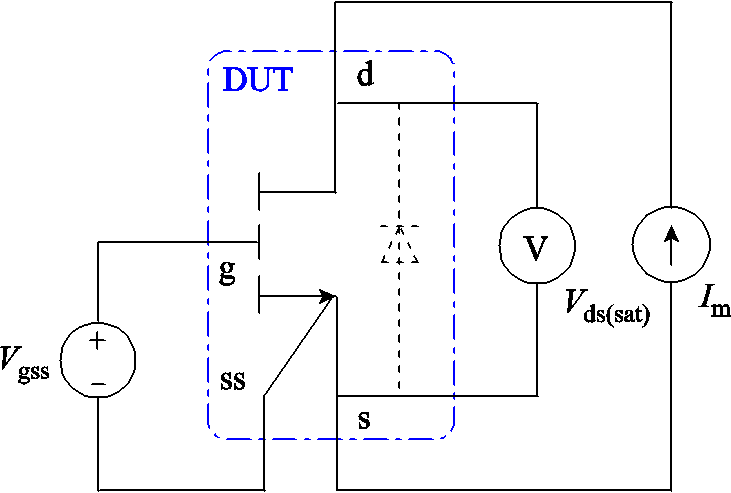
图2 小电流饱和压降测量电路
Fig.2 Measurement circuit for saturation voltage with low current injection
当GaN器件导通后,器件工作在线性区,此时漏源极饱和压降Vds(sat)≤Vgss-Vth,可表示为[31]
 (1)
(1)
式中,L为沟道长度;Δd为沟道厚度;W为栅宽;d和ε分别为AlGaN势垒层的厚度和介电常数;μ为电子迁移率; 为漏源极电流;Vgss为栅极电压;Vth为阈值电压。
为漏源极电流;Vgss为栅极电压;Vth为阈值电压。
由于GaN器件的电子迁移率μ对温度T敏感,其具有负温度特性,会随温度升高而降低[32],因此在器件漏极注入恒定的测试电流Ids情况下,器件的漏源极饱和压降Vds(sat)随着电子迁移率μ的减小而增大。因此,GaN器件的漏源极饱和压降Vds(sat)具有正温度特性,会随着器件结温升高而增大。
阈值电压定义为在室温下器件漏极流过指定电流时在器件栅源极施加的电压,通常指定的漏极电流为μA或mA级[33]。图3给出了GaN器件阈值电压的测量电路,其中DUT为漏-栅极短路的待测器件,Im为恒流源向DUT提供的指定的测试电流。测试时,待DUT达到热平衡状态后,向漏极注入恒定的测试电流Im,测量DUT栅极电压Vgss,该栅极电压即为器件的阈值电压。
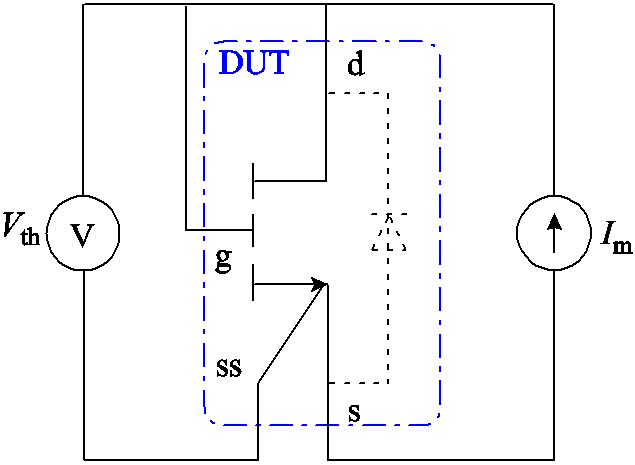
图3 阈值电压测量电路
Fig.3 Measurement circuit for threshold voltage
GaN器件阈值电压可表示为[34]
式中, 为势垒高度;ΔEc为AlGaN/GaN异质结的导带阶;q为基本电荷量,常取q=1.6×10-19 C);Nd为掺杂密度;σ为AlGaN/GaN界面处的总极化电荷密度。
为势垒高度;ΔEc为AlGaN/GaN异质结的导带阶;q为基本电荷量,常取q=1.6×10-19 C);Nd为掺杂密度;σ为AlGaN/GaN界面处的总极化电荷密度。
由于势垒高度 、AlGaN/GaN异质结的导带阶ΔEc和总极化电荷密度σ对温度敏感,均具有明显的正温度特性[35],因此GaN器件阈值电压是温度的函数。当温度变化时,器件阈值电压会因势垒高度
、AlGaN/GaN异质结的导带阶ΔEc和总极化电荷密度σ对温度敏感,均具有明显的正温度特性[35],因此GaN器件阈值电压是温度的函数。当温度变化时,器件阈值电压会因势垒高度 、AlGaN/GaN异质结的导带阶ΔEc和总极化电荷密度σ的主导程度的强弱而呈现不同的变化趋势。
、AlGaN/GaN异质结的导带阶ΔEc和总极化电荷密度σ的主导程度的强弱而呈现不同的变化趋势。
虽然GaN器件不存在如MOSFET器件的寄生体二极管,但其反向导通特性与MOSFET器件体二极管类似[36]。参考MOSFET体二极管测量方法[37],GaN器件的类体二极管压降测量电路如图4所示。电流源Im为DUT提供指定的测试电流,电压源Vgss为DUT提供指定栅极电压。测试时,将器件栅极与漏极短接,待DUT达到热平衡状态后,向源极注入脉冲式测试电流Im,测量DUT源极和漏极间电压Vsd(body),该漏源极电压为器件的类体二极管压降。
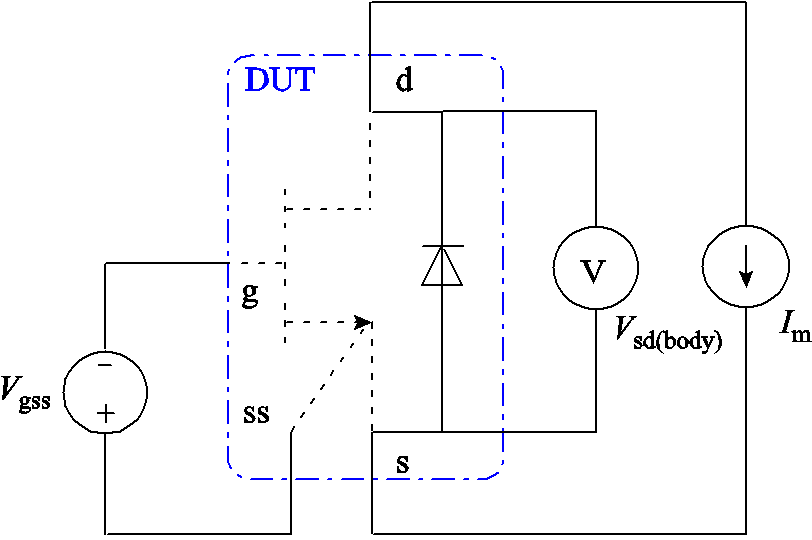
图4 类体二极管压降测量电路
Fig.4 Measurement circuit for body-like diode voltage
当GaN器件处于反向导通模态时,器件呈现出类体二极管工作特性,漏源极压降Vsd(body)为[38]
 (3)
(3)
式中,Rsd(on)为反向导通电阻。
由于反向导通电阻Rsd(on)和阈值电压Vth均受温度的影响,其中Rsd(on)具有正温度特性[21],因此当GaN器件注入恒定的源漏极电流Isd时,类体二极管压降Vsd(body)会因器件反向导通电阻Rsd(on)和阈值电压Vth的温度特性而具有相关联的温度特性。
图5所示为用于测试小电流饱和压降、阈值电压和类体二极管压降的三种温敏电参数特性的实验平台,用于测试的DUT为GaN Systems公司的GS61008P。为抑制实验中温控平台的温度对测试电路的影响,实验平台采用分立式结构,将仅有DUT的印制电路板(Printed Circuit Board, PCB)基板安装在温控平台上,单独加热,其他测试电路经接口与基板连接。驱动电路用于控制DUT通断;恒流源电路用于提供恒定测试电流;为采集微弱的变化信号,放大电路采用具有高增益、高共模抑制比的仪表放大器。

图5 实验平台示意图
Fig.5 Diagram of experimental equipment
在实验中,使用温控平台将DUT的温度依次设定为25℃、50℃、75℃、100℃和125℃,即每个温度点保持足够长时间(设定为10 min)以确保DUT达到热平衡状态,可视器件结温与设定温度相同。考虑测试电路中元件易受温度的影响,故设定实验最高温度为125℃,以评估GaN器件的温敏特性。图6给出了实验测试时序。在测试过程中,测试电流Im以脉冲形式注入DUT以保证测试时长的一致性,且在脉冲电流注入器件2 s后触发采集实验数据以确保实验平台工作在稳定状态。实验数据采用自触发信号之后的100 μs的数据,通过多次重复测量并平均处理以降低实验误差。
为探索器件栅极电压对TSEP温度特性的影响,图7给出了可调式驱动电路原理,包括常规驱动电路和输入电压可调电路,其中驱动芯片选择应用手册推荐的SI8271GB-IS。为了使输出信号具有稳定性和低噪声特性,采用模拟器件LM317作为电压调节器。通过电阻R1与可调电阻R2实现输出电压Vcc的调节,从而获得可调栅极电压Vgss。
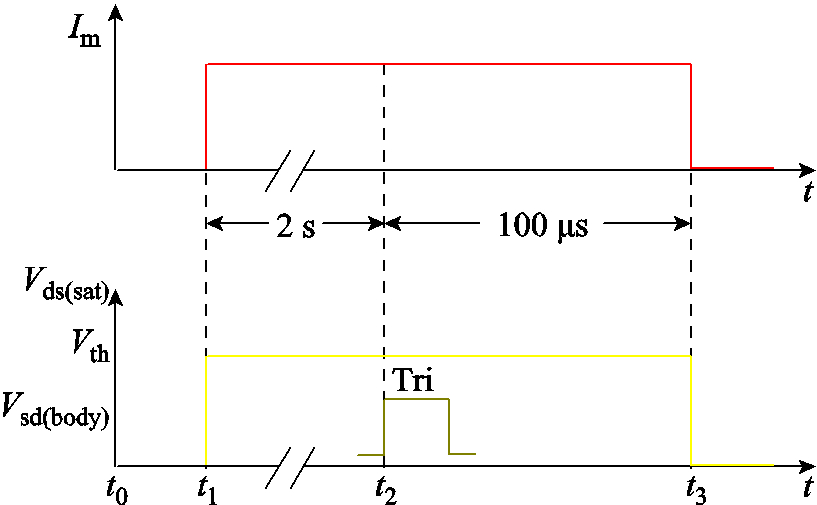
图6 测量时序图
Fig.6 Measurement timing diagram
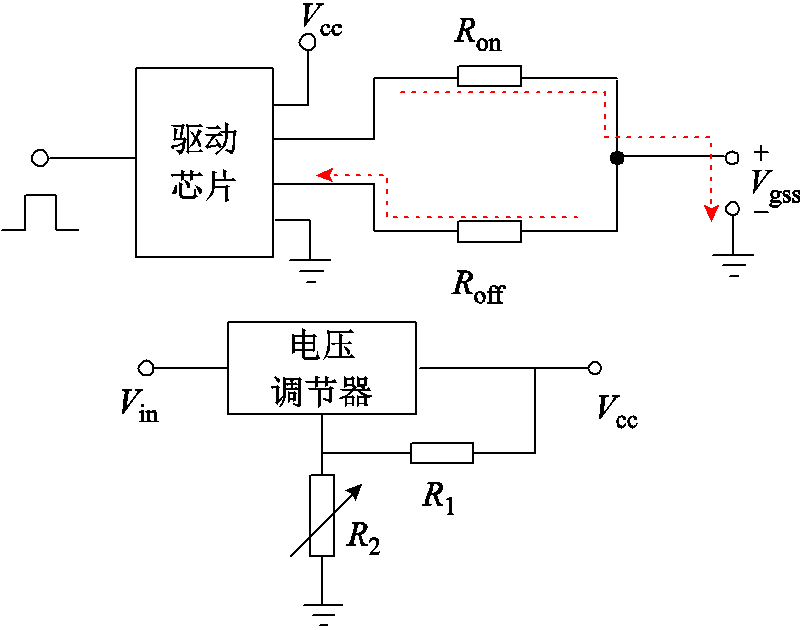
图7 可调节驱动电路
Fig.7 Adjustable drive circuit
依据原理图搭建输出电压约为5 V的驱动电路,并将其放置在温控平台进行验证,在结温分别为25℃、50℃、75℃、100℃和125℃的条件下测得的驱动电压的温度特性见表1。
表1 驱动电压的温度特性
Tab.1 Temperature characteristics of the driving voltage

结温/℃驱动电压/V 255.012 505.010 755.006 1005.011 1255.005
分析可得,在实验温度变化范围内,驱动电压最大偏差为0.24%,因此在本实验中可以忽略驱动电路在测试过程中受温度的影响。
图8给出了一种简易可控的恒流源电路,用于提供脉冲式mA级测试电流。PNP三极管V1工作在放大状态,基极电流足够小可忽略不计,输出的集电极电流 近似等于发射极电流
近似等于发射极电流 ,即
,即
 (4)
(4)
式中,UVD1为稳压二极管VD1两端压降;Ueb为V1发射极与基极的压降电压;R1为采样电阻。通过调节采样电阻R1大小可设定恒流源输出的大小。另外,电阻R2用于限制接地回路的电流,为VD1提供稳态工作点。在此基础上,采用光耦芯片ACPL-P346控制后级恒流源所需的电压Vout。

图8 恒流源电路
Fig.8 Constant current circuit
依据原理图搭建输出电流大小为100 mA的恒流源电路,并将其放置在温控平台进行验证,在结温分别为25℃、50℃、75℃、100℃和125℃的条件下,测得的测试电流的温度特性见表2。
表2 测试电流的温度特性
Tab.2 Temperature characteristics of the test current

结温/℃测试电流/mA 2599.887 5099.755 7599.631 100100.35 12599.956
分析可得,在实验温度变化范围内,测试电流最大偏差为0.37%,因此可以忽略恒流源电路在测试过程中受温度的影响。
为精准测量微弱的小电流饱和压降,图9给出了采用AD8221构建具有输入阻抗大、输出阻抗小和共模抑制比高的仪表放大电路。
该电路外接电阻RG用于调节电压增益,电阻R与电容CC组成两组低通RC网络,用于滤除电路中的高频信号,抑制共模干扰,电容CD影响差动信号。放大电路的增益G为
 (5)
(5)
式中,电阻R1=49.4 kΩ。
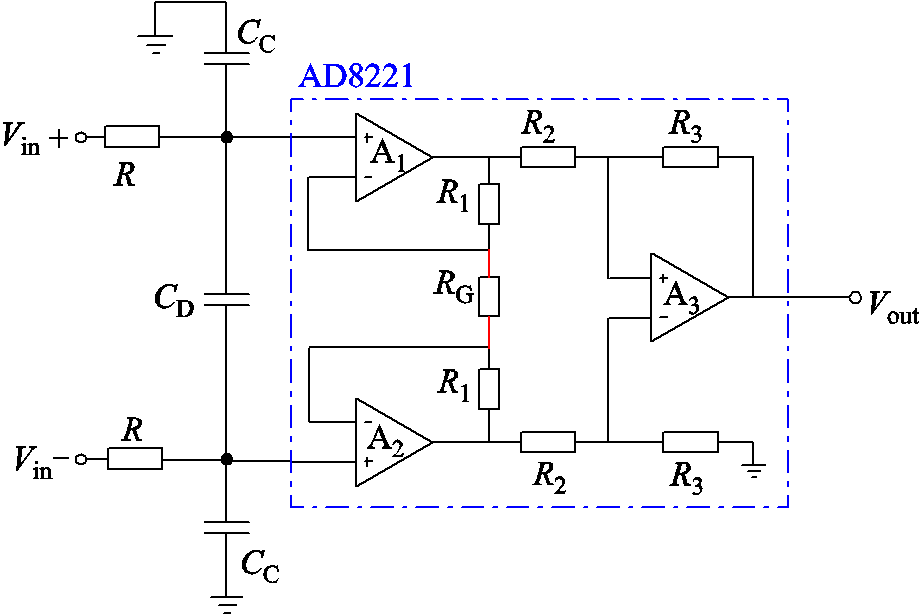
图9 放大电路
Fig.9 Amplifier circuit
为满足测量需求,本文设置的放大增益为495,则外接电阻RG为100 Ω。
依据原理图搭建放大倍数约为495的放大电路,并将恒流源输出端通过阻值约为0.1 Ω的电阻连接至其输入端,然后放置在温控平台进行验证,在结温分别为25℃、50℃、75℃、100℃和125℃的条件下测得的输出电压的温度特性见表3。
表3 输出电压的温度特性
Tab.3 Temperature characteristics of the output voltage

结温/℃输出电压/V 255.105 505.108 755.097 1005.10 1255.108
分析可得,输出电压最大偏差为0.16%,因此可以忽略测试过程中温度对放大电路的影响。
本节针对GaN器件的小电流饱和压降Vds(sat)、阈值电压Vth和类体二极管压降Vsd(body)三种TSEPs进行温敏特性和稳定性两方面的实验研究。在温敏特性研究中,主要探讨三种TSEPs的线性度、灵敏度,以及关联参数对温敏特性的影响。在稳定性研究中,提出波动系数来表征器件TSEPs的稳定程度,并考虑不同测试循环条件下器件TSEPs的稳定性。最后,从线性度、灵敏度、关联参数和稳定性四个方面对上述三种TSEPs的特性进行对比说明。
3.1.1 小电流饱和压降的温敏特性
根据图2所示的小电流饱和压降测试原理图和DUT数据手册,器件栅极电压Vgss设定为5 V,注入的恒定测试电流Im设定为300 mA。图10展示了同一款两个GaN器件的Vds(sat)-Tj曲线,可见小电流饱和压降Vds(sat)随结温升高而增大,其变化趋势与理论分析一致。另外,所测器件Vds(sat)具有良好的线性度,其拟合优度为0.998左右。但从Vds(sat)-Tj曲线的斜率可以看到,Vds(sat)灵敏度为0.015 mV/℃左右,远小于Si基和SiC基器件[39-40],这对基于Vds(sat)的GaN器件结温的提取提出了挑战。
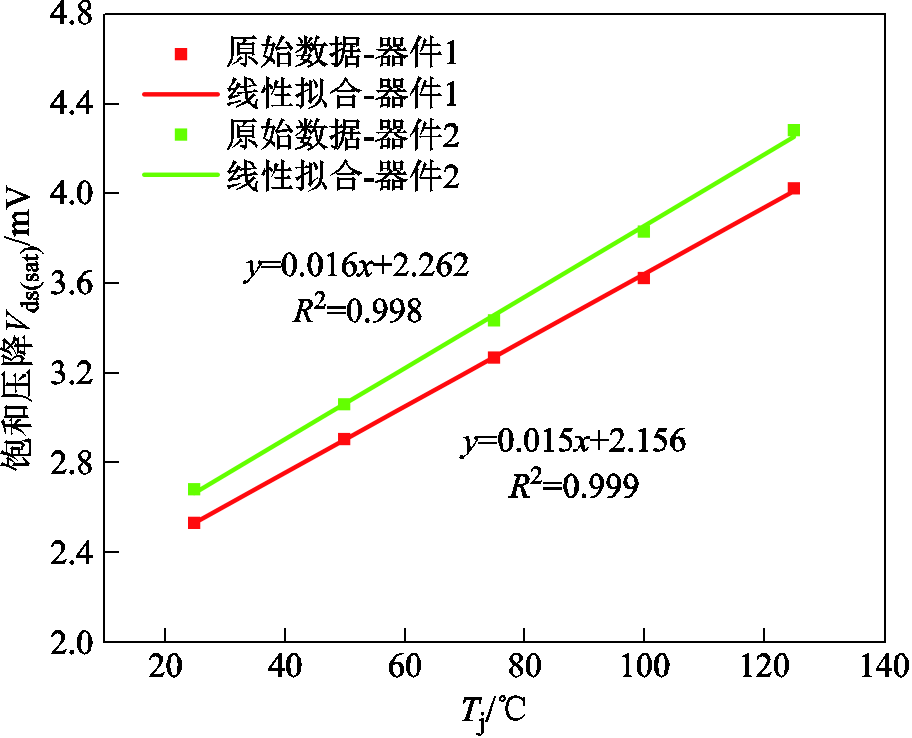
图10 小电流饱和压降的温度特性
Fig.10 Temperature characteristics of saturation voltage with low current injection
为研究测试电流Im对小电流饱和压降Vds(sat)温敏特性的影响,Vgss保持为5 V,Im从100 mA依次增大到300 mA,实验结果如图11a所示。可以看到,在不同Im条件下,Vds(sat)均具有正温度系数,且保持较好的线性度。然而,Vds(sat)灵敏度受Im的影响较大。Im越小,Vds(sat)的灵敏度越低,从0.016 mV/℃下降至0.006 mV/℃。由此可见,注入较小的Im会增加Vds(sat)测量难度;反之,增大Im虽然有利于提高小电流饱和压降的灵敏度,但会引起严重的器件自热效应,在结温监测中引入测量误差。根据器件结-壳热阻RΘJC和器件损耗P,结-壳温差如式(6)所示,其中RΘJC=0.55℃/W。

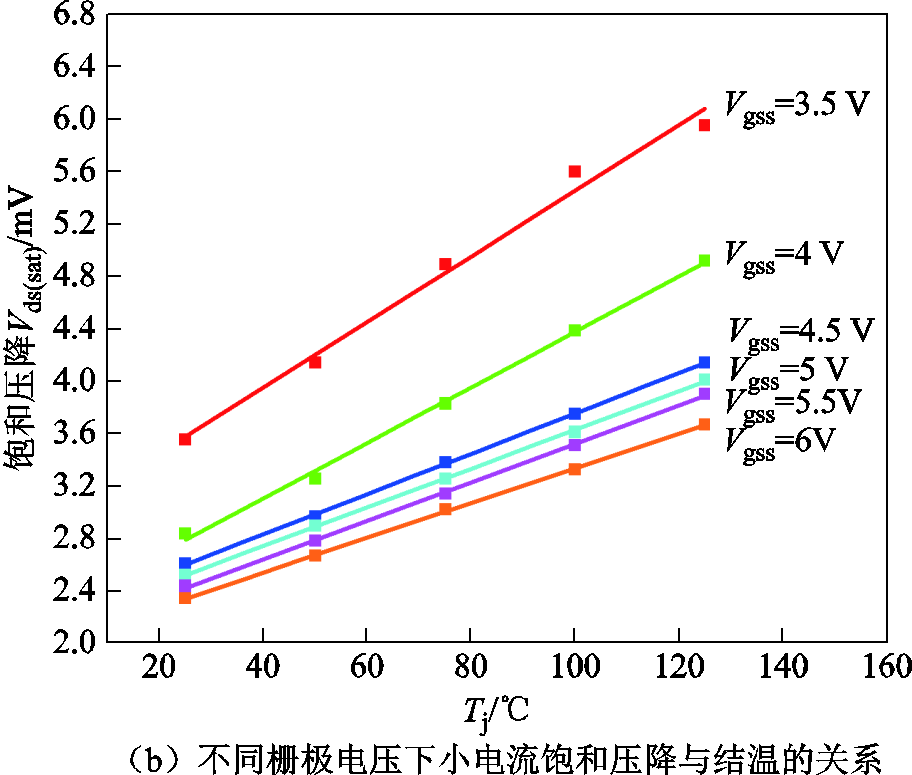
图11 小电流饱和压降与结温的关系
Fig.11 Relationship between saturation voltage with low current injection and junction temperature
 (6)
(6)
本文实验中所选择的最大测试电流为300 mA,根据式(6),其引起的器件结-壳温差远小于0.001℃,可以忽略自热效应。
为探究栅极电压Vgss对小电流饱和压降Vds(sat)温敏特性的影响,Im保持为300 mA,Vgss变化范围为3.5~6 V,实验结果如图11b所示。可以看到,在不同Vgss条件下,Vds(sat)均具有正温度系数,且Vgss越大,其线性拟合度越好。然而,随着Vgss从 3.5 V增加至6 V,Vds(sat)灵敏度从0.025 mV/℃下降至0.013 mV/℃;当Vgss在4.5~6 V内时,Vds(sat)灵敏度在0.013~0.015 mV/℃小范围变化。由式(1)可知,在相同的温度和测试电流下,当Vgss越接近Vth时,Vds(sat)越大,此时Vgss对Vds(sat)有放大的特性。由于电子迁移率随着温度的增大而减小,因此Vds(sat)具有正温度特性;并且随着Vgss越接近Vth,Vds(sat)灵敏度随Vgss变化就越显著。然而,当Vgss Vth时,Vgss对Vds(sat)的放大特性减弱甚至被抑制,器件Vds(sat)的灵敏度随Vgss变化就趋于稳定。
Vth时,Vgss对Vds(sat)的放大特性减弱甚至被抑制,器件Vds(sat)的灵敏度随Vgss变化就趋于稳定。
3.1.2 阈值电压的温敏特性
根据图3所示的阈值电压测量原理图和DUT数据手册,当注入器件的测试电流Im为10 mA时,阈值电压的温度特性如图12所示。首先,不同于Si基和SiC基MOSFET器件[41-43],被测GaN器件的阈值电压Vth具有正温度特性。根据式(2),这可能是因为被测器件Vth中势垒高度随温度的变化起主导作用。其次,DUT的Vth灵敏度在1.6~1.9 mV/℃范围内,小于Si基器件的阈值电压[44]。最后,Vth的拟合优度弱于小电流饱和压降。
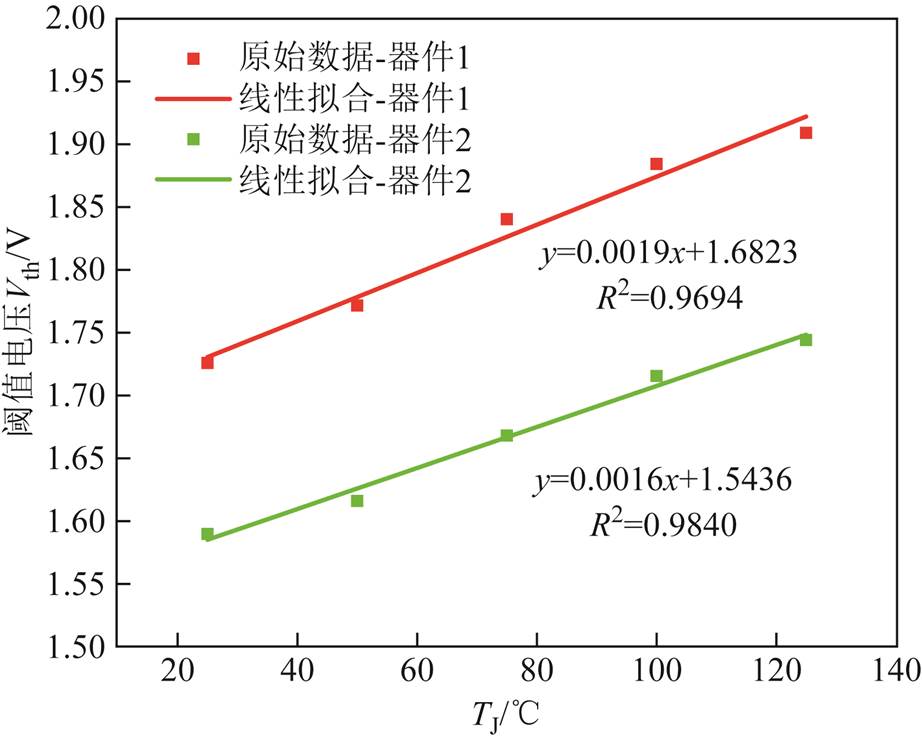
图12 阈值电压的温度特性
Fig.12 Temperature characteristics of threshold voltage
为研究测试电流Im对阈值电压Vth温敏特性的影响,结合器件数据手册推荐的Im值,设定Im分别为5 mA、10 mA、15 mA、20 mA和25 mA,实验结果如图13所示。可以看到,Vth仍具有正温度系数,其初值随Im增大而增大。但相较于小电流饱和压降,Vth线性度一般,且具有一定的离散性。
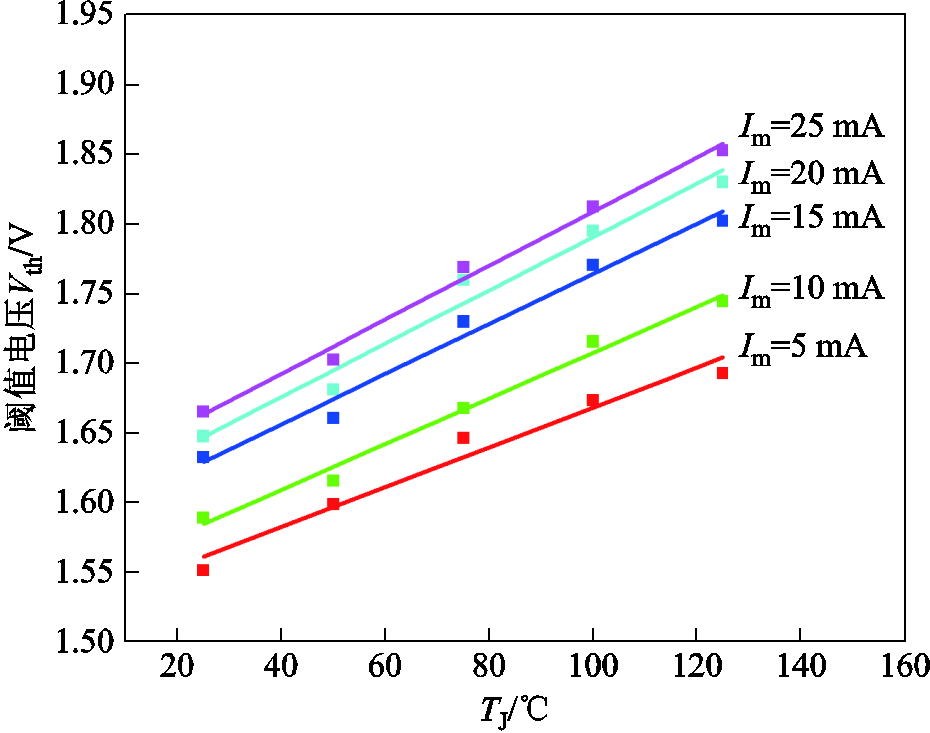
图13 不同测试电流下阈值电压与结温的关系
Fig.13 Relationship between threshold voltage and junction temperature under different currents
3.1.3 类体二极管压降的温敏特性
根据图4所示的类体二极管压降测量原理图,设定测试电流Im为100 mA,栅极电压Vgss为0 V,同一款两个GaN器件在不同温度下的类体二极管压降Vsd(body)的实验结果如图14所示。可以看到,类体二极管压降Vsd(body)随结温升高而增大,与阈值电压Vth随温度的变化趋势相似。由式(3)可知,具有正温度特性的阈值电压和反向导通电阻会使被测GaN器件的类体二极管压降同样具有正温度特性。其次,Vsd(body)具有较好的线性度,其拟合优度在0.98左右。最后,Vsd(body)灵敏度范围在2 mV/℃左右,远大于小电流饱和压降灵敏度。
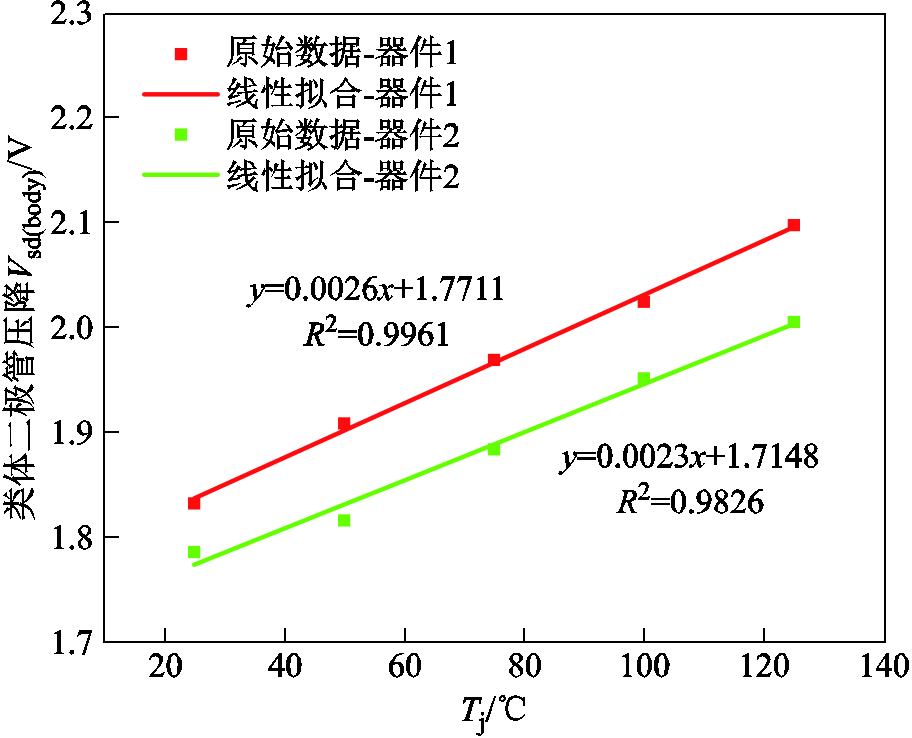
图14 类体二极管压降的温度特性
Fig.14 Temperature characteristics of body-like diode voltage
为研究测试电流Im对类体二极管压降Vsd(body)温敏特性的影响,保持Vgss为0 V,设定Im为多组值,实验结果如图15所示。可以看到,不同测试电流Im下,Vsd(body)均具有正温度系数,且保持较好的线性度。随着测试电流Im的增大,Vsd(body)的初值小幅度增加,而Vsd(body)灵敏度变化较小,在设定Im变化范围内,Vsd(body)灵敏度依然在2 mV/℃左右。

图15 不同测试电流下类体二极管压降与结温的关系
Fig.15 Relationship between body-like diode voltage and junction temperature under different currents
3.2.1 基于温度循环的温敏电参数稳定性
特别地,在实验中DUT在经过温度循环后,同一个温敏电参量在相同的外部测试条件下会发生参数漂移,即稳定性不一致现象。所述温度循环是指在相同的测试条件下,器件循环加热并在同温度点进行TSEPs测量。当测试温度达到单轮最高温度后,首先,采用自然冷却的方式降温,然后再进行下一轮循环测试。同时,为提高每一温度点下测试数据的准确性,对同一温度点的数据进行多次测量处理。为表征器件温敏电参数的稳定性,借鉴均值和标准差概念,定义波动系数(Fluctuation Coefficients, FC)为
 (7)
(7)
其中
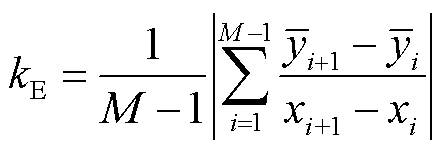
式中,M为每轮循环下的测量点总数; 为第i个测量点处所有循环结果的归一化均值;xi为第i个测量点处的归一化自变量;CV(Yi)为第i个测量点处所有循环结果的变异系数,用以表征该测量点处所有循环数据的离散程度,即
为第i个测量点处所有循环结果的归一化均值;xi为第i个测量点处的归一化自变量;CV(Yi)为第i个测量点处所有循环结果的变异系数,用以表征该测量点处所有循环数据的离散程度,即
 (8)
(8)
式中,N为循环轮数;yij为第i个测量点处第j次循环的结果。可见,波动系数FC越小,单位灵敏度下的数据波动越小,温敏电参数越稳定。
为说明所测试GaN器件TSEPs的稳定性,选取了Infineon公司的GaN器件和Cree公司SiC MOSFET器件进行对比参照,相关信息见表4。
表4 待测器件的相关信息
Tab.4 Information of device under test

序号测试器件类型厂家 AGS61008PeGaN HEMTInfineon GaN BIGT60R070D1eGaN HEMT CCMF20120DSiC MOSFETCree
针对小电流饱和压降Vds(sat)的稳定性,通过对每款DUT进行三轮温度循环,注入的测试电流同为300 mA。在25℃初始温度下测得的三款器件的Vds(sat)见表5。器件A的Vds(sat)明显小于器件B和器件C。为更好地说明器件温敏参量的特性,对测量数据采用归一化处理,图16展示了不同器件归一化Vds(sat)的温度循环测试结果。可以看到,所有器件在经过三轮温度循环后,曲线重合度较好。
表5 在25℃下的小电流饱和压降
Tab.5 Saturation voltage with low current injection at 25℃

器件Vds(sat)/mV A2.57 B16.72 C297
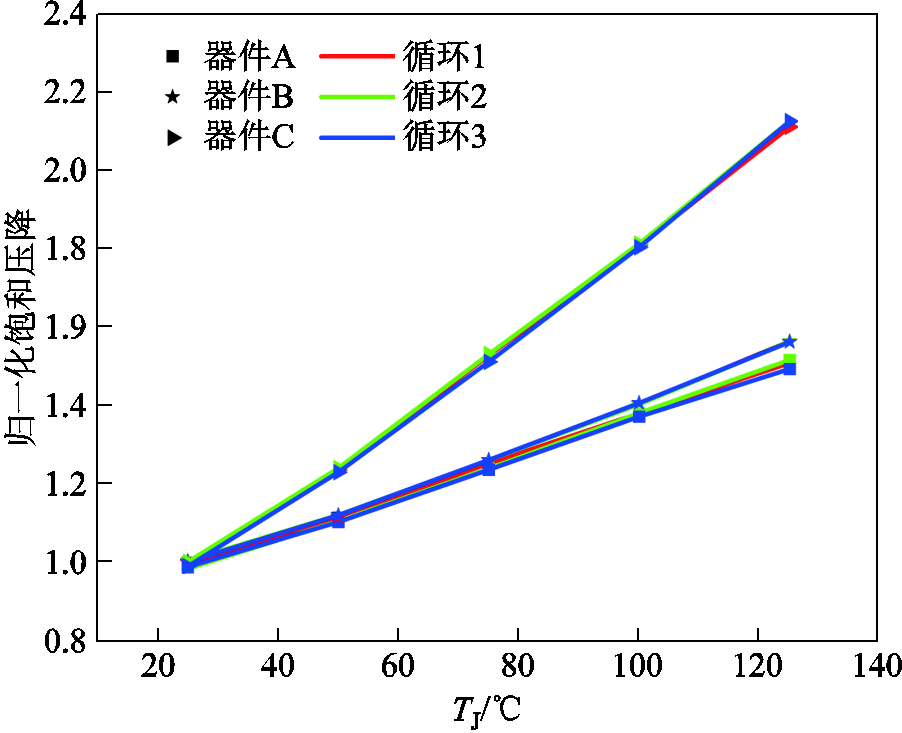
图16 温度循环下不同器件归一化小电流饱和压降
Fig.16 Normalized saturation voltage with low current injection under temperature cycling for different devices
另外,GaN器件的灵敏度远低于SiC MOSFET,可见Vds(sat)作为TSEP在GaN器件结温提取中更具挑战性。根据式(7),在温度循环下三款器件Vds(sat)的波动系数见表6,器件A的波动系数较其他器件较高。为方便说明GaN器件温敏电参数的稳定性,结合后续测量结果,参考SiC MOSFET器件的温敏电参数(Vds(sat)、Vth和Vsd(body))中最大波动系数,以波动系数等于0.2为判断阈值,GaN器件的Vds(sat)具有良好的稳定性,有利于Vds(sat)在结温测量中应用。
表6 三款器件Vds(sat)的波动系数
Tab.6 Fluctuation coefficients of Vds(sat) of three devices

待测器件Vds(sat)波动系数 A0.161 B0.032 C0.055
针对阈值电压Vth的稳定性,对每款器件进行三轮温度循环,注入测试电流同为10 mA。在25℃初始温度下,GaN器件的阈值电压远大于SiC MOSFET,相应器件的阈值电压初始值见表7。图17展示了不同器件归一化Vth温度循环测试结果,可以看到器件A的Vth出现了显著波动,器件B和器件C波动较小;而且器件A的线性度明显弱于器件B和器件C。特别地,同为GaN器件的A和B,两款器件的Vth呈现相反的温度特性,这可能是由于势垒高度 、AlGaN/GaN异质结的导带阶ΔEc和总极化电荷密度σ在不同温度下的主导程度不同。
、AlGaN/GaN异质结的导带阶ΔEc和总极化电荷密度σ在不同温度下的主导程度不同。
表7 在25℃下的阈值电压
Tab.7 Threshold voltage at 25℃

待测器件Vth/V A2.09 B1.47 C5.22
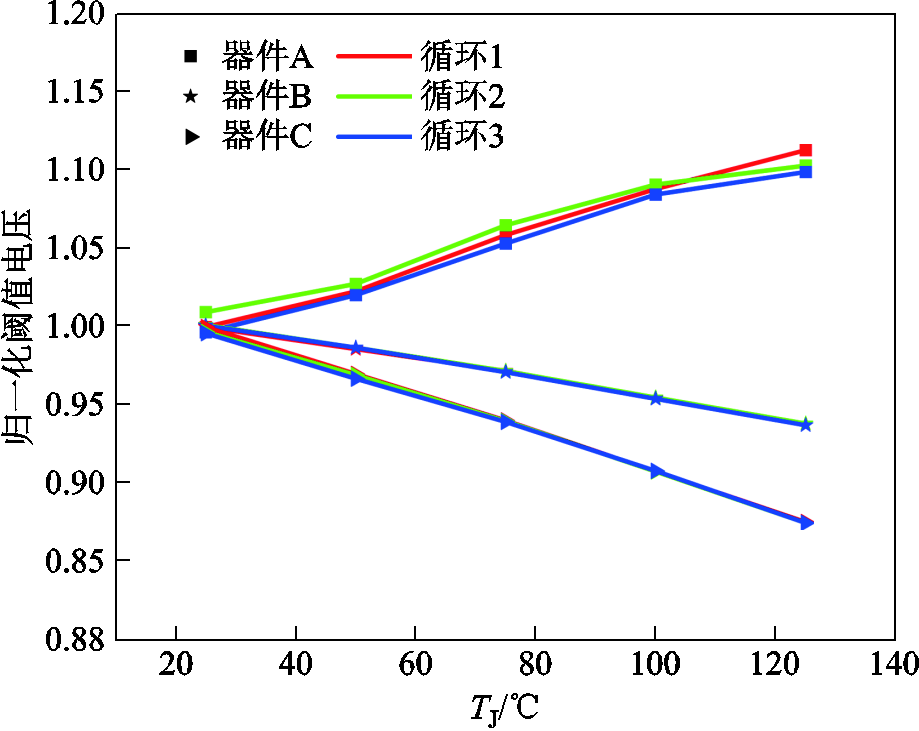
图17 温度循环不同器件归一化阈值电压
Fig.17 Normalized threshold voltage under temperature cycling for different devices
根据式(7),在温度循环下三款器件Vth的波动系数见表8,可见器件A的波动系数远大于其他器件。以波动系数等于0.2为判断阈值,若器件A采用Vth作为TSEP进行结温测量时,需要重点考虑Vth的稳定性影响。
表8 三款器件Vth的波动系数
Tab.8 Fluctuation coefficients of Vth of three devices

待测器件Vth波动系数 A0.639 B0.112 C0.103
针对类体二极管压降Vsd(body)的稳定性,对每款器件进行三轮温度循环,器件栅极电压均设置为0 V,测试电流同为100 mA。在25℃初始温度下,器件A的Vsd(body)大于器件B和器件C,相应的(类)体二极管压降Vsd(body)见表9。三款器件Vsd(body)归一化结果如图18所示,可以看到器件A的Vsd(body)存在轻微的波动性。类似地,相较于器件A类体二极管压降的正温度特性,同为GaN器件的器件B类体二极管压降呈现负温度特性。根据式(3)推断,这是由于器件B的阈值电压具有负温度特性。
表9 在25℃下的(类)体二极管压降
Tab.9 Body (like) diode voltage at 25℃

待测器件Vsd(body)/V A1.83 B1.51 C0.56
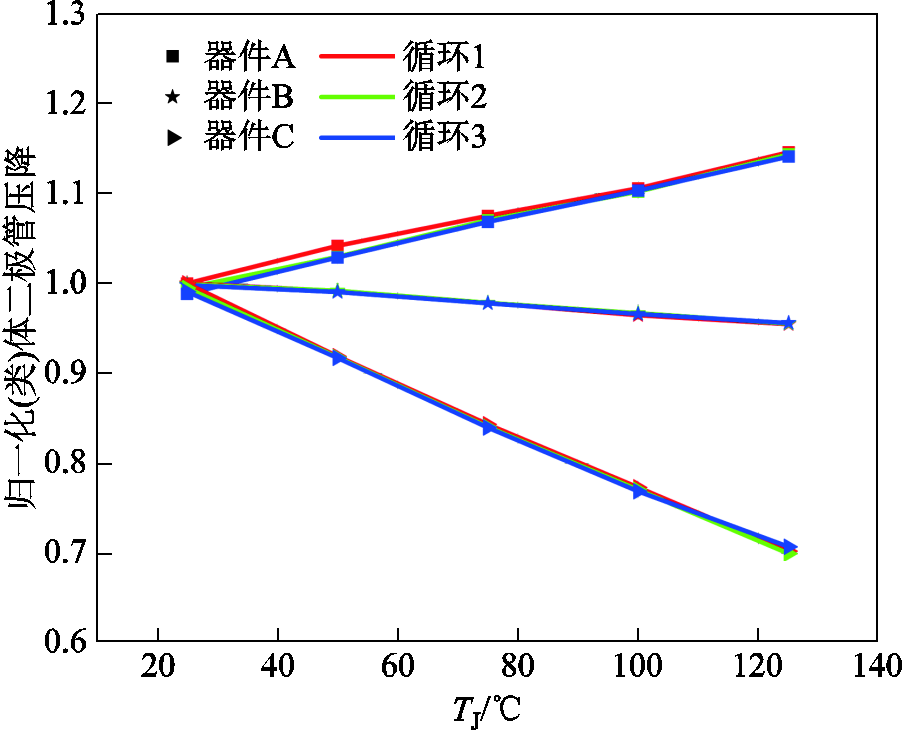
图18 温度循环下不同器件归一化(类)体二极管压降
Fig.18 Normalized body (like) diode voltage under temperature cycling for different devices
根据式(7),在温度循环下三款器件Vsd(body)的波动系数见表10,由表10可见,相较于其他器件,器件A的波动系数更高。以波动系数等于0.2为判断阈值,GaN器件若采用Vsd(body)作为TSEP进行结温测量时,也需要考虑Vsd(body)的稳定性影响。
表10 三款器件Vsd(body)的波动系数
Tab.10 Fluctuation coefficients of Vsd(body) of three devices

待测器件Vsd(body)波动系数 A0.347 B0.212 C0.142
3.2.2 基于电流循环的温敏电参数稳定性
根据温度循环实验结果可知,在多轮温度循环中,GS61008P器件的部分温敏电参量所展现的稳定性并不理想。考虑测试时均需向器件注入一定的测试电流,为此本文进一步探索该款器件温敏电参量在测试电流循环下的稳定性。实验中,在相同的温度下,每轮对五个测试电流点由低到高进行测试,当测试电流达到单轮设定的最大电流后,再进行下一轮循环测试。为保证每个电流点测试结果的准确性,对其进行多次测量处理。
当DUT温度稳定在25℃时,三种TSEPs在相应测试电流下初始大小见表11。图19展示了电流循环下DUT归一化的三种温敏电参量。可以看到,小电流饱和压降Vds(sat)的曲线重合度较好,阈值电压Vth和类体二极管压降Vsd(body)存在轻微波动。根据式(7),在电流循环下DUT的三种TSEPs的波动系数见表12。可以看到,相较于温度循环,三种温敏电参数在电流循环下的波动系数更小,其中Vds(sat)的波动系数最小,Vth的波动系数最高,可见小电流饱和压降稳定性更好。
表11 在初始测试电流下DUT的三种TSEPs
Tab.11 Three TSEPs of DUT at initial test current

参数TSEPs值 Vds(sat)@100mA/mV0.91 Vth@5mA/V1.55 Vsd(body)@40mA/V1.69
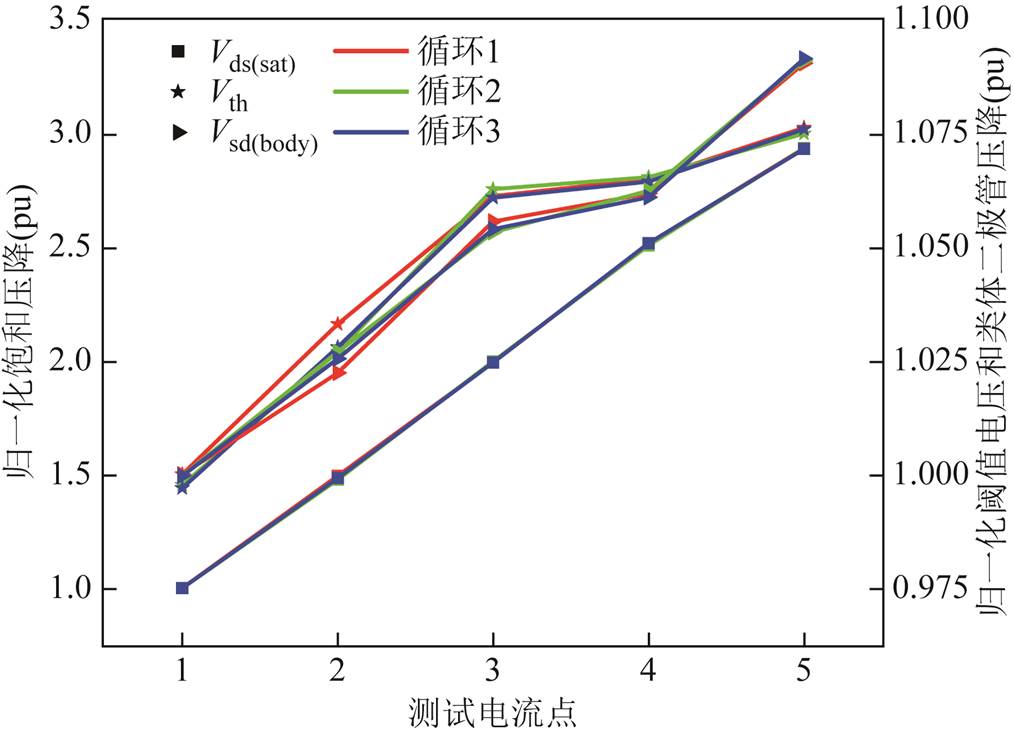
图19 电流循环归一化温敏电参数
Fig.19 Normalized temperature-sensitive electrical parameters for current cycling
表12 基于电流循环的三种TSEPs的波动系数
Tab.12 Fluctuation coefficients of three TSEPs based on current cycling

温敏电参数波动系数 Vds(sat)0.007 Vth0.229 Vsd(body)0.102
本节从线性度、灵敏度、稳定性和关联参数四个方面分别对各TSEP进行说明。在线性度方面,小电流饱和压降Vds(sat)作为TSEP与温度呈良好的线性关系;相比较阈值电压Vth和类体二级管压降Vsd(body)具有较好的线性度。从灵敏度的角度看,类体二级管压降Vsd(body)和阈值电压Vth的灵敏度一般,但远高于小电流饱和压降Vds(sat)的灵敏度。在稳定性方面,相较于阈值电压Vth和类体二级管压降Vsd(body),小电流饱和压降Vds(sat)具有较好的稳定性。从关联参数角度来看,三种TSEPs均受结温Tj和测试电流Im的影响,并且使用Vds(sat)进行结温测量时还需额外考虑栅极电压Vgss对其的影响。表13为GaN器件的三种温敏电参数特性在不同角度的综合比较。
表13 GaN器件温敏电参数特性的综合比较
Tab.13 Comprehensive comparison of TSEPs characteristics for GaN device

温敏电参数线性度灵敏度稳定性关联参数 Vds(sat)良好很小良好Tj、Vgss、Im Vth一般一般一般Tj、Im Vsd(body)较好一般较好Tj、Im
目前,基于温敏电参数法的GaN器件结温监测技术尚处于探索阶段,对稳态温敏参数特性的研究有助于其在结温监测等可靠性检测中的应用。本文针对小电流饱和压降、阈值电压和类体二极管压降三个温敏电参量,给出了各参量的测试条件,提出了以波动系数表征TSEPs的稳定性,评估了参量的温敏特性,可以得到以下结论:GaN器件的小电流饱和压降具有良好的线性度和稳定性,其灵敏度受测试电流和栅极电压的影响。总体而言,小电流饱和压降具有潜在的结温测量应用价值。另外,阈值电压和(类)体二极管压降作为TSEPs在不同器件中表现出明显的趋势差异。特别地,对于部分GaN器件,阈值电压的稳定性并不理想,这在具体应用中需要给予考虑。
参考文献
[1] Gonzalez J O, Wu Ruizhu, Jahdi S, et al. Performance and reliability review of 650 V and 900 V silicon and SiC devices: MOSFETs, cascode JFETs and IGBTs[J]. IEEE Transactions on Industrial Electronics, 2020, 67(9): 7375- 7385.
[2] Gareau J, Hou Ruoyu, Emadi A. Review of loss distribution, analysis, and measurement techniques for GaN HEMTs[J]. IEEE Transactions on Power Electronics, 2020, 35(7): 7405-7418.
[3] 赵方玮, 李艳, 魏超, 等. GaN器件动态导通电阻精确测试与影响因素分析[J]. 电工技术学报, 2022, 37(18): 4664-4675.
Zhao Fangwei, Li Yan, Wei Chao, et al. Accurate measurement of dynamic on-resistance of GaN devices and affecting factor analysis[J]. Transactions of China Electrotechnical Society, 2022, 37(18): 4664-4675.
[4] Zhang Guidong, He Yuanhang, Yu S S, et al. Switching transition modeling of eGaN HEMT in power converters[J]. IEEE Transactions on Power Electronics, 2023, 38(4): 4251-4256.
[5] 菅沼, 克昭. SiC/GaN功率半导体封装和可靠性评估技术[M]. 北京: 机械工业出版社, 2021.
Jian Zhao, Ke Zhao. SiC/GaN power semiconductor packaging and reliability evaluation techniques[M]. Beijing: China Machine Press,2021,02.
[6] Yang Yanyong, Zhang Pinjia. In situ insulated gate bipolar transistor junction temperature estimation method via a bond wire degradation independent parameter turn-OFF vce overshoot[J]. IEEE Transactions on Industrial Electronics, 2021, 68(10): 10118-10129.
[7] 常桂钦, 罗海辉, 方超, 等. 散热底板对IGBT模块功率循环老化寿命的影响[J]. 电工技术学报, 2024, 39(8): 2485-2495.
Chang Guiqin, Luo Haihui, Fang Chao, et al. Influence of heat dissipation baseplate on power cycling lifetime of IGBT modules[J]. Transactions of China Electrotechnical Society, 2024, 39(8): 2485-2495.
[8] Mandeya R, Chen Cuili, Pickert V, et al. Prethreshold voltage as a low-component count temperature sensitive electrical parameter without self-heating[J]. IEEE Transactions on Power Electronics, 2018, 33(4): 2787-2791.
[9] Deng Erping, Borucki L, Lutz J. Correction of delay-time-induced maximum junction temperature offset during electrothermal characterization of IGBT devices[J]. IEEE Transactions on Power Electronics, 2021, 36(3): 2564-2573.
[10] 魏云海, 陈民铀, 赖伟, 等. 基于IGBT结温波动平滑控制的主动热管理方法综述[J]. 电工技术学报, 2022, 37(6): 1415-1430.
Wei Yunhai, Chen Minyou, Lai Wei, et al. Review on active thermal control methods based on junction temperature swing smooth control of IGBTs[J]. Transactions of China Electrotechnical Society, 2022, 37(6): 1415-1430.
[11] 杨舒萌, 孙鹏菊, 王凯宏, 等. 恒流驱动下基于VeE_max的IGBT模块解耦老化影响的结温测量方法[J]. 电工技术学报, 2022, 37(12): 3038-3047, 3072.
Yang Shumeng, Sun Pengju, Wang Kaihong, et al. Junction temperature measurement method of IGBT modules based on VeE_max under constant-current source drive which decouples fatigue effect[J]. Transactions of China Electrotechnical Society, 2022, 37(12): 3038-3047, 3072.
[12] Kuball M, Hayes J M, Uren M J, et al. Measurement of temperature in active high-power AlGaN/GaN HFETs using Raman spectroscopy[J]. IEEE Electron Device Letters, 2002, 23(1): 7-9.
[13] Bagnall K R, Moore E A, Badescu S C, et al. Simultaneous measurement of temperature, stress, and electric field in GaN HEMTs with micro-Raman spectroscopy[J]. The Review of Scientific Instruments, 2017, 88(11): 113111.
[14] 崔曼, 胡震, 张腾飞, 等. 基于壳温信息的功率器件可靠性分析[J]. 电工技术学报, 2023, 38(24): 6760-6767.
Cui Man, Hu Zhen, Zhang Tengfei, et al. Reliability analysis of power device based on the case temperatures[J]. Transactions of China Electrotechnical Society, 2023, 38(24): 6760-6767.
[15] Hu Zhen, Du Mingxing, Wei Kexin, et al. An adaptive thermal equivalent circuit model for estimating the junction temperature of IGBTs[J]. IEEE Journal of Emerging and Selected Topics in Power Electronics, 2019, 7(1): 392-403.
[16] 李华康, 宁圃奇, 康玉慧, 等. SiC MOSFET器件高温下最大电流导通能力评估方法[J]. 电源学报, 2024, 22(2): 386-395.
Li Huakang, Ning Puqi, Kang Yuhui, et al. Evaluation method for maximum current conduction capability of SiC MOSFET device at high temperature[J]. Journal of Power Supply, 2024, 22(2): 386-395.
[17] Zhou Ziyu, Sui Yi, Zhang Xu, et al. IGBT temperature field monitoring based on reduced-order model[J]. CES Transactions on Electrical Machines and Systems, 2023, 7(2): 129-136.
[18] Lu Shengchang, Zhang Zichen, Buttay C, et al. Improved measurement accuracy for junction-to-case thermal resistance of GaN HEMT packages by gate-to-gate electrical resistance and stacking thermal interface materials[J]. IEEE Transactions on Power Electronics, 2022, 37(6): 6285-6289.
[19] Yang Fei, Pu Shi, Xu Chi, et al. Turn-on delay based real-time junction temperature measurement for SiC MOSFETs with aging compensation[J]. IEEE Transactions on Power Electronics, 2021, 36(2): 1280-1294.
[20] Li Xuan, Feng Shiwei, Liu Chang, et al. A drain–source connection technique: thermal resistance measurement method for GaN HEMTs using TSEP at high voltage[J]. IEEE Transactions on Electron Devices, 2020, 67(12): 5454-5459.
[21] 王岩. 基于温敏电参量的GaN HEMT器件结温测量研究[D]. 重庆: 重庆大学, 2022.
Wang Yan. Research on junction temperature measurement of gan hemt based on thermosensitive electrical parameters[D]. Chongqing: Chongqing University, 2022.
[22] McDonald T, Butler S W. Progress and current topics of JEDEC JC-70.1 power GaN device quality and reliability standards activity: or: what is the avalanche capability of your GaN transistor?[C]//2021 IEEE International Reliability Physics Symposium (IRPS), Monterey, CA, USA, 2021: 1-6.
[23] Pan Shijie, Feng Shiwei, Zheng Xiang, et al. Effects of temperature and bias voltage on electron transport properties in GaN high-electron-mobility transistors [J]. IEEE Transactions on Device and Materials Reliability, 2021, 21(4): 494-499.
[24] Hedayati M H, Wang Jianjing, Dymond H C P, et al. Overtemperature protection circuit for GaN devices using a di/dt sensor[J]. IEEE Transactions on Power Electronics, 2021, 36(7): 7417-7428.
[25] Sharma K, Muñoz Barón1 K, Ruthardt J, et al. Characterisation of the junction temperature of gallium-nitride power devices via quasi-threshold voltage as temperature sensitive electrical parameter [C/OL]//The 10th International Conference on Power Electronics, Machines and Drives (PEMD 2020), Online Conference, 2020: 932-936.
[26] Shan Yanwei, Gao Wei, Huang Zeyou, et al. Test methods and principles of thermal resistance for GaN HEMT power devices[C]//2020 21st International Conference on Electronic Packaging Technology (ICEPT), Guangzhou, China, 2020: 1-4.
[27] Franke J, Zeng Guang, Winkler T, et al. Power cycling reliability results of GaN HEMT devices[C]//2018 IEEE 30th International Symposium on Power Semiconductor Devices and ICs (ISPSD), Chicago, IL, USA, 2018: 467-470.
[28] Zheng Xiang, Feng Shiwei, Zhang Yamin, et al. Evaluation of the Schottky contact degradation on the temperature transient measurements in GaN HEMTs [J]. IEEE Transactions on Electron Devices, 2018, 65(5): 1734-1738.
[29] Borghese A, Riccio M, Longobardi G, et al. Gate leakage current sensing for in situ temperature monitoring of p-GaN gate HEMTs[J]. Microelectronics Reliability, 2020, 114: 113762.
[30] IEC 60747—9 Semiconductor Devices Discrete Devices Part 9: Insluated-Gate Biploar Transistors (IGBTs)[S]. International Electrotechnical Commission: Geneva, Switzerland, 2007: 60747- 60749.
[31] 徐跃杭, 徐锐敏, 李言荣. 微波氮化镓功率器件等效电路建模理论与技术[M]. 北京: 科学出版社, 2017.
[32] Chattopadhyay M K, Tokekar S. Thermal model for dc characteristics of algan/GAN HEMTS including self-heating effect and non-linear polarization[J]. Microelectronics Journal, 2008, 39(10): 1181-1188.
[33] Huang A. Infineon optimos power mosfet datasheet explanation[J]. Application Note AN, 2012, 3: 2012.
[34] Rashmi, Kranti A, Haldar S, et al. Comprehensive analysis of small-signal parameters of fully strained and partially relaxed high Al-content lattice mismatched Alm/Ga1-m/N/GaN HEMTs[J]. IEEE Transactions on Microwave Theory and Techniques, 2003, 51(2): 607-617.
[35] Alim M A, Rezazadeh A A, Gaquiere C. Temperature dependence of the threshold voltage of AlGaN/GaN/ SiC high electron mobility transistors[J]. Semiconductor Science and Technology, 2016, 31(12): 125016.
[36] Jones E A, Wang F, Ozpineci B. Application-based review of GaN HFETs[C]//2014 IEEE Workshop on Wide Bandgap Power Devices and Applications, Knoxville, TN, USA, 2014: 24-29.
[37] González J A O, Alatise O. A novel non-intrusive technique for BTI characterization in SiC mosfets[J]. IEEE Transactions on Power Electronics, 2019, 34(6): 5737-5747.
[38] 秦海鸿. 氮化镓电力电子器件原理与应用[M]. 北京: 北京航空航天大学出版社, 2020.
[39] 陈杰, 邓二平, 赵雨山, 等. 高压大功率器件结温在线测量方法综述[J]. 中国电机工程学报, 2019, 39(22): 6677-6688.
Chen Jie, Deng Erping, Zhao Yushan, et al. Review of on-line junction temperature measurement methods of high voltage power electronics[J]. Proceedings of the CSEE, 2019, 39(22): 6677-6688.
[40] 冒俊杰, 高洪艺, 李成敏, 等. 基于电致发光效应的非接触式碳化硅MOSFET结温在线检测方法研究[J]. 中国电机工程学报, 2022, 42(3): 1092-1103.
Mao Junjie, Gao Hongyi, Li Chengmin, et al. Research on non-contact on-line junction temperature detection method of SiC mosfet based on electroluminescence effect[J]. Proceedings of the CSEE, 2022, 42(3): 1092-1103.
[41] Zeng Guang, Cao Haiyang, Chen Weinan, et al. Difference in device temperature determination using p-n-Junction forward voltage and gate threshold voltage[J]. IEEE Transactions on Power Electronics, 2019, 34(3): 2781-2793.
[42] Jiang Xi, Wang Jun, Yu Hengyu, et al. Online junction temperature measurement for SiC MOSFET based on dynamic threshold voltage extraction[J]. IEEE Tran-sactions on Power Electronics, 2021, 36(4): 3757-3768.
[43] 吴涛, 孙鹏, 赵志斌, 等. 基于温敏电参数的碳化硅MOSFET结温测量方法综述[J]. 中国电机工程学报, 2021, 41(11): 3904-3915.
Wu Tao, Sun Peng, Zhao Zhibin, et al. A review of junction temperature measurement methods of SiC MOSFET by temperature-sensitive electrical para-meters[J]. Proceedings of the CSEE, 2021, 41(11): 3904-3915.
[44] Zhang Liqi, Liu Pengkun, Guo Suxuan, et al. Comparative study of temperature sensitive electrical parameters (TSEP) of Si, SiC and GaN power devices[C]//2016 IEEE 4th Workshop on Wide Bandgap Power Devices and Applications (WiPDA), Fayetteville, AR, USA, 2016: 302-307.
Research on Steady-State Temperature-Sensitive Electric Parameters Characteristics of GaN Devices
Abstract Gallium Nitride (GaN) devices have the advantages of fast switching speed, high switching frequency, and small on-resistance, which have been deeply applied in fast charging devices, data centers, and 5G devices. However, as the physical dimensions of GaN devices decrease and the power density of application devices increases, the heat flux density of the devices significantly increases, thus the junction temperature has become an important factor that cannot be ignored in the reliability of GaN devices. The junction temperature monitoring technology of GaN devices based on temperature-sensitive electrical parameters (TSEPs) is still in the exploratory stage. The study of steady-state TSEPs characteristics is helpful for the reliabilityof devices such as health management based on junction temperature. To deeply understand the steady-state TSEPscharacteristics of GaN devices, this paper explores three common steady-state TSEPs: the saturation voltage with low current injection, threshold voltage, and body-like diode voltage.
Firstly, referring to the related literature and theparameter measurement standards of power switching devices, three measurement methods of TSEPs are given and physical characteristics of TSEPs related to junction temperature are analyzed, which provides a reference for subsequent parameter characteristics research. Secondly, the experimental platformis built, and the measurement circuitsare introduced for studying the characteristics of the three TSEPs. In addition, to ensure that the influence of temperature on the measurement circuit is as small as possible, the measurement circuit adopts a split type and vertical layout. The experimental results show that the influence of temperature on the measuring plate is negligible. Finally, the temperature-sensitive characteristics and stability of the three TSEPs are studied. In terms of temperature-sensitivecharacteristics, the linearity and sensitivity of the three TSEPs are mainly discussed.Also, the potential influence of the test current and gate voltageis specifically researched. In terms of stability, different types and models of the devicesare tested for comparison to ensure the feasibility of the experiment and explainthe characteristics of the device. The fluctuation coefficient is proposed to characterize the stability of TSEPs, and the stability of three parameters is evaluatedbased on the temperature cycle and current cycle experiments. The linearity, sensitivity, correlation parameters, and stability of the three TSEPs are compared.
The experimental results show thatthe saturation voltage with low current injection increases with rising junction temperature, and exhibits a positive temperature coefficient under the condition of increasing test current and decreasing gate voltage. Unlike Si-based and SiC-based MOSFET devices, the threshold voltage of the tested GaN device demonstrates a positive temperature characteristic. Similarly, the body-likediode voltage increases with the test current, but it presents a positive temperature coefficient characteristic, which is different from the temperature characteristic of common diodes or body diodes inside MOSFET.
To summarize, the main contributions of this paper are: the saturation voltage with low current injectionof GaN deviceshas good linearity and stability, butits sensitivity is affected by the test current and gate voltage. Overall, it has potential application value in junction temperature measurement. In addition, the threshold voltage and body-like diode voltage as TSEPs show obvious differences among different devices. In particular, for some GaN devices, the stability of the threshold voltage is not ideal, which needs to be considered in specific applications.
keywords:GaN devices, reliability, temperature-sensitive electrical parameters, junction temperature monitoring
中图分类号:TM46
DOI: 10.19595/j.cnki.1000-6753.tces.231480
国家自然科学基金联合基金(U22A20226)、宜昌市自然科学研究项目(A23-2-019)、湖北省自然科学基金(2024AFB234)和广西自治区重点研发计划(2022AB05028)资助项目。
收稿日期 2023-09-07
改稿日期 2023-12-21
王凯宏 男,1992年生,博士,讲师,研究方向为电力电子系统可靠性。
E-mail:wangkaihong@ctgu.edu.cn
邾玢鑫 男,1986年生,博士,教授,研究方向为电力电子变换器。
E-mail:zhubinxin40@163.com(通信作者)
(编辑 郭丽军)